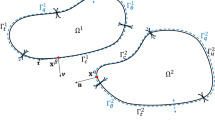Abstract
This paper presents a general framework for modeling dynamic large deformation contact-impact problems based on the phantom-node extended finite element method. The large sliding penalty contact formulation is presented based on a master-slave approach which is implemented within the phantom-node X-FEM and an explicit central difference scheme is used to model the inertial effects. The method is compared with conventional contact X-FEM; advantages, limitations and implementational aspects are also addressed. Several numerical examples are presented to show the robustness and accuracy of the proposed method.































Similar content being viewed by others
References
Kobayashi S, Kobayashi S, Oh S-I, Altan T (1989) Metal forming and the finite-element method, vol 4. Oxford University Press on Demand, Oxford
Ambrosio JAC (2003) Contact and impact models for vehicle crashworthiness simulation. Int J Crashworthiness 8(1):73–86
Lim CT, Shim VPW, Ng YH (2003) Finite-element modeling of the ballistic impact of fabric armor. Int J Impact Eng 28(1):13–31
Yao H, Gao H (2006) Mechanics of robust and releasable adhesion in biology: bottom-up designed hierarchical structures of gecko. J Mech Phys Solids 54(6):1120–1146
Liu F, Borja RI (2009) An extended finite element framework for slow-rate frictional faulting with bulk plasticity and variable friction. Int J Numer Anal Meth Geomech 33(13):1535–1560
Dolbow J, Moës N, Belytschko T (2001) An extended finite element method for modeling crack growth with frictional contact. Comput Methods Appl Mech Eng 190(51):6825–6846
Hughes TJR, Cottrell JA, Bazilevs Y (2005) Isogeometric analysis: cad, finite elements, nurbs, exact geometry and mesh refinement. Comput Methods Appl Mech Eng 194(39):4135–4195
Belytschko T, Black T (1999) Elastic crack growth in finite elements with minimal remeshing. Int. J. Numer. Methods Eng. 45(5):601–620
Khoei AR, Shamloo A, Azami AR (2006) Extended finite element method in plasticity forming of powder compaction with contact friction. Int J Solids Struct 43(18):5421–5448
Khoei AR, Nikbakht M (2007) An enriched finite element algorithm for numerical computation of contact friction problems. Int J Mech Sci 49(2):183–199
Elguedj T, Gravouil A, Combescure A (2007) A mixed augmented lagrangian-extended finite element method for modelling elastic-plastic fatigue crack growth with unilateral contact. Int J Numer Meth Eng 71(13):1569–1597
Liu F, Borja RI (2008) A contact algorithm for frictional crack propagation with the extended finite element method. Int J Numer Methods Eng 76(10):1489–1512
Liu F, Borja RI (2010) Stabilized low-order finite elements for frictional contact with the extended finite element method. Comput Methods Appl Mech Eng 199(37):2456–2471
Hirmand M, Vahab M, Khoei AR (2015) An augmented lagrangian contact formulation for frictional discontinuities with the extended finite element method. Finite Elem Anal Des 107:28–43
Geniaut S, Massin P, Moës N (2007) A stable 3D contact formulation using X-FEM. Eur J Comput Mech 16(2):259–275
Nistor I, Guiton MLE, Massin P, Moës N, Geniaut S (2009) An X-FEM approach for large sliding contact along discontinuities. Int J Numer Methods Eng 78(12):1407–1435
Liu F, Borja RI (2010) Finite deformation formulation for embedded frictional crack with the extended finite element method. Int J Numer Methods Eng 82(6):773
Khoei AR, Mousavi SMT (2010) Modeling of large deformation-large sliding contact via the penalty X-FEM technique. Comput Mater Sci 48(3):471–480
Song J-H, Areias P, Belytschko T (2006) A method for dynamic crack and shear band propagation with phantom nodes. Int J Numer Methods Eng 67(6):868–893
Nistor I, Pantalé O, Caperaa S (2008) Numerical implementation of the extended finite element method for dynamic crack analysis. Adv Eng Softw 39(7):573–587
Chau-Dinh T, Zi G, Lee P-S, Rabczuk T, Song J-H (2012) Phantom-node method for shell models with arbitrary cracks. Comput Struct 92:242–256
de Souza Neto EA, Peric D, Owen DRJ (2011) Computational methods for plasticity: theory and applications. Wiley, Hoboken
Khoei AR (2014) Extended finite element method: theory and applications. wiley
Menouillard T, Rethore J, Moes N, Combescure A, Bung H (2008) Mass lumping strategies for X-FEM explicit dynamics: application to crack propagation. Int J Numer Methods Eng 74(3):447–474
de Borst R, Remmers JJC, Needleman A (2006) Mesh-independent discrete numerical representations of cohesive-zone models. Eng Fract Mech 73(2):160–177
Hansbo A, Hansbo P (2004) A finite element method for the simulation of strong and weak discontinuities in solid mechanics. Comput Methods Appl Mech Eng 193(33–35):3523–3540
Rabczuk T, Belytschko T (2007) A three-dimensional large deformation meshfree method for arbitrary evolving cracks. Comput Methods Appl Mech Eng 196(29):2777–2799
Talebi H, Samaniego C, Samaniego E, Rabczuk T (2012) On the numerical stability and mass-lumping schemes for explicit enriched meshfree methods. Int J Numer Methods Eng 89(8):1009–1027
Flanagan DP, Belytschko T (1981) A uniform strain hexahedron and quadrilateral with orthogonal hourglass control. Int J Numer Methods Eng 17(5):679–706
Hesch C, Betsch P (2011) Transient three-dimensional contact problems: mortar method. mixed methods and conserving integration. Comput Mech 48(4):461–475
Author information
Authors and Affiliations
Corresponding author
Rights and permissions
About this article
Cite this article
Broumand, P., Khoei, A.R. General framework for dynamic large deformation contact problems based on phantom-node X-FEM. Comput Mech 61, 449–469 (2018). https://doi.org/10.1007/s00466-017-1463-7
Received:
Accepted:
Published:
Issue Date:
DOI: https://doi.org/10.1007/s00466-017-1463-7




